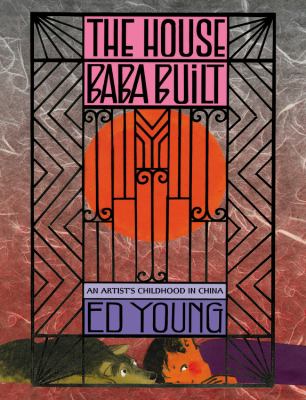
by Ed Young and Libby Koponen
Book list *Starred Review* With war coming to Shanghai, Young's father did the best he could to protect his wife and children. An engineer, he built a house strong enough to withstand attack and large enough to hold his growing family and, later, others as well. Koponen writes from Young's point of view, creating a portrait of the artist as a growing child and acknowledging the wisdom of his father, Baba. Although war casts a shadow over this memoir, the narrative vividly relates details from Young's childhood: sharing roller skates with his siblings, raising silkworms from eggs, drawing pictures in his textbooks, and watching cricket fights. Taking full advantage of the book's large format and many foldout pages, Young juxtaposes drawings, photos, and cut papers to create striking visual and textural effects in collages that suggest both the sharpness and the patchy quality of childhood memories. The text smoothly combines the story's elements, integrating an adult's understanding with a child's experiences. The final pages offer photos of family members, a time line, a diagram of the house, and a note about the book's creation. Add this vibrant memoir to the list of children's WWII experiences by writers and illustrators, including Michael Foreman's War Boy (1990), Tomie dePaola's I'm Still Scared (2006), and Allan Say's Drawing from Memory (2011).--Phelan, Caroly. Copyright 2010 Booklist From Booklist, Copyright © American Library Association. Used with permission. Publishers Weekly In this picture book memoir by the Caldecott Medalist, which opens in 1931 (the year he was born), the stock market has crashed, and China is in turmoil. Young's father, Baba, persuades a landowner in Shanghai to let him construct a huge brick house on his land; Baba promises to return the house after 20 years, long enough to keep his family safe until WWII ends. Young's creation, shaped with help from author Libby Koponen, is as complex and labyrinthine as Baba's house, with foldout pages that open to reveal drawings, photos, maps, and memories. Tender portraits of his siblings, torn-paper collages showing tiny figures at play, and old photos of stylish adults intermingle, as if they'd been found forgotten in a drawer. Young's fans will savor stories of his East-West childhood; he and his four siblings raise silkworms, watch Westerns, train fighting crickets, and dance the conga when the war finally ends 14 years later. "Life," Baba writes to his children, "is not rich not real unless you partake life with your fellow man"; Young set the course of his life by his father's words. It's history at its most personal. All ages. (Oct.) (c) Copyright PWxyz, LLC. All rights reserved. (c) Copyright PWxyz, LLC. All rights reserved School Library Journal Gr 3-8-Young brings his exquisite sense of design, expressive brushwork, and mastery of a variety of mediums to the story of his childhood in China. A note explains how Koponen helped shape the stream-of-consciousness text. In the opening spread, birds lift off from the bottom of the brown pages, filling the heavens. Red rice paper forms the delicate outlines of Young's parents and their five children, connecting them as one transparent image. The text reads: "War was spreading to Shanghai, my father said, like the crows that came in summer.." Baba, an engineer, made a deal with a landlord in the safest part of the city: he would build a large brick home with gardens and a pool and give it to the landlord after inhabiting it for 20 years. The layers of cut paper and collage build, much like the house, which grew to accommodate relatives and refugees. This catalog of childhood pleasures (cricket battles, rooftop roller skating, silkworm hatching) is punctuated by distant bombs, fighter planes, and food rationing. Each scene is a surprise, as Young works in postcards, maps, currency, magazine images, family photographs, and acrylic portraits. Gatefold pages extend the scale. An illustrated afterword portrays Young's own children at the household gates as well as a time line and floor plans. This tale of filial devotion provides a fascinating contrast to Allen Say's Drawing from Memory (Scholastic, 2011) in which the Japanese-American artist describes his estrangement from his father and the nurturing received from his mentor.-Wendy Lukehart, Washington DC Public Library (c) Copyright 2011. Library Journals LLC, a wholly owned subsidiary of Media Source, Inc. No redistribution permitted. (c) Copyright 2010. Library Journals LLC, a wholly owned subsidiary of Media Source, Inc. No redistribution permitted. School Library Journal Gr 3-8-In this exquisitely designed and illustrated memoir, Young describes his family and the haven his father built in Shanghai for his wife and children but later opened up to refugees fleeing the horrors of World War II. The dynamic, mixed-media art is constructed with inventive foldouts, vibrant color, and layered collage. (Sept.) (c) Copyright 2011. Library Journals LLC, a wholly owned subsidiary of Media Source, Inc. No redistribution permitted. (c) Copyright 2010. Library Journals LLC, a wholly owned subsidiary of Media Source, Inc. No redistribution permitted. |